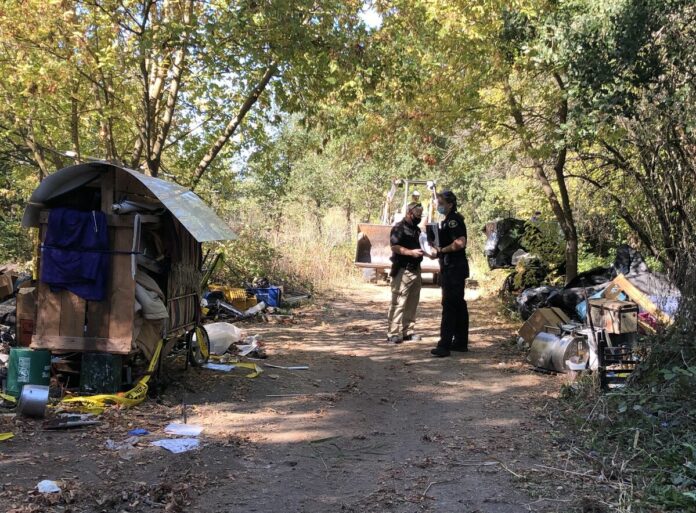On an empty stomach in the late morning heat, Charles Edward Dahlquist III divided his belongings into what to take and what to leave with the help of homeless advocates during an encampment sweep on Sept. 22 in Sebastopol.
“That is awesome, sitting down. Usually, sitting down, you take it for granted. Now, it’s like eating after fasting,” he said, settling onto an upside-down bucket.
Five fires have broken out in the last several months in the Laguna de Santa Rosa Wetlands Preserve area, where last week as many as 20 people lived along the trails approaching the park, according to Tim Miller, executive director of West County Community Services (WCCS).
Sebastopol Police Chief Kevin Kilgore said the encampments and fires have become a public safety risk for those living there, their neighbors on Morris Street and nearby businesses. RVs line Morris Street, across from the Barlow.
Officers and advocates informed the unhoused community in and around the preserve at least two weeks in advance of the sweep that they needed to vacate and seek shelter with community services or on their own elsewhere by this Wednesday, Miller said.
The effort brought together the city, its public works department, the Sebastopol Police Department, the county’s Homeless Encampment Access & Resource Team (HEART), Sonoma Applied Village Services (SAVS) and WCCS to smooth the transition.
Wednesday’s approach involved a number of advocates stepping into the wooded trails to begin the clearing process ahead of law enforcement, whose presence may not be as trusted or positive from a homeless person’s perspective.
Offering plastic bags to pack, Cheryl Rood, a SAVS outreach worker, said she’s attended most of the encampment clearings in the county over the last two years. Besides helping people pack and ensuring they don’t lose anything in the process, Rood said she drives homeless people places, helps them get storage and into a shelter.
“Most people, even though they know it’s happening, they get really emotionally scrambled. They know it’s coming but they don’t know where to go,” she said.
“They know about the shelters, they know everything, but they’re still scared,” Rood said. Their neighbors become family in an encampment, in a way, and she said many people feel more secure out there than in a shelter. “Most of them have been through a lot.”
Police officers approached individuals with forms to sign that they explained meant the campers would agree that items left behind or not otherwise identified to keep could be thrown out. Public works employees operated trucks and what appeared to be a bulldozer to scoop up materials deemed disposable. Some belongings could be collected and stored at the police department for a time, to retrieve later.
Dahlquist chatted with people from SAVS sharing plastic bags for storage and helping pack up his belongings. He talked about his experiences amiably and matter-of-factly, familiar with some advocates, but shared that being expelled from an area is still jarring.
“It’s a big problem,” he said of homelessness, describing his own campsite as becoming “ridiculous” with mess over time.
Still, “If we see that we can be somewhere, we’re going to be there. Just to not get harassed or moved on, that’s more important than not getting stolen from or not getting violent because that move-around-move-around thing, you know, it shows you how not in control you are,” Dahlquist said. “It’s degrading. Even if they’re not trying to, even if that’s not their goal, it doesn’t matter. It’s ‘Oh, you feel comfortable there, now go.’”
An officer came to him with the form to sign.
“They’re more humane here, in Sebastopol,” Dahlquist said, compared to law enforcement in other parts of Sonoma County. Some he considered “totalitarian,” without naming any particular.
Dahlquist stayed to rake the remaining debris of his campsite away from trees so public works staff would have an easier time and to encourage friendlier relations overall, noting his interactions with law enforcement tend to go smoother when he’s calm, courteous and straightforward.
“Today, every person here was offered housing if they wanted it. Some of them accepted, some of them moved on. Some family came, or friends, and picked them up early this morning and took them hopefully inside into their home,” Miller said as the day wore past noon.
A few unhoused people accepted shelter last week and at least two others were in the finalization process that afternoon to receive shelter, he said. “These are always difficult, but I think it’s going well. The main goal is, in an as minimally traumatizing way as possible, to move the folks who are encamped here to a safer and better place,” Miller said of the clearing.
The collaboration between city, county and nonprofit providers has been going especially well, he said, while providing more health and mental health services before sweeps occur is always a key aspect that can be improved.
Early on, Miller walked along a pathway with a case of water bottles, humming so he wouldn’t startle anyone he might come across with his tall frame.
A woman helped move her boyfriend’s belongings out to the sidewalk on Morris Street. He lives along the trails, while she lives in her car. “I honestly don’t really have a plan. It’s like we’re being chased from one corner to the next for a long time and I don’t know,” she said. “I don’t think most anybody has a plan because everything requires money, you know what I mean?… Most people around here are tapped out.”









